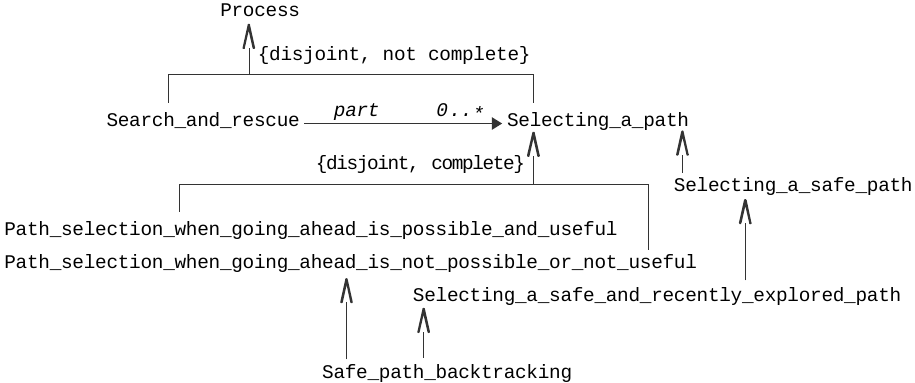





















Knowledge (Representations; KRs):
information that is, at least partially, represented and organized
- in some logics
- via by semantic relations
(subtype, part, instrument, result, time, place, ... and 100s more)
Knowledge Base (KB):
- ontology (set of formal terms + KRs defining them)
- base of facts (KRs about objects that are not types)
Not just a database!
General Knowledge Sharing (KS):
designing+relating KBs so that their KRs are reusable for/by ANY application
1. Panorama of complementary ways to support general knowledge sharing
1.1. Tools to import/export any kind of knowledge, in any formal language
1.2. General-purpose ontologies aligning top-level ones and lexical ones
1.3. KB servers that support non-restricting KB Sharing by Web users
1.4. KB servers that support networked KBs
2. Examples of representations for general Knowledge Sharing
in disaster management
Problems: most KR languages (KRLs) - have expressiveness restrictions (→ restrict or bias KS), and/or - are low-level (→ hard to read, not normalizing)
Solutions: - concise+expressive+high-level KR notations, e.g. FE and FL - exploitation of an ontology of KR models and notations
Problems: “reusable” ontologies are hardly reused and hard to reuse together. E.g.: - different KBs hardly top-level ontologies and lexical ones, or the same ones, because - most reusable ontologies (top-level ontologies, lexical ones, ...) are not/poorly aligned.
Solution: general-purpose ontologies aligning top-level ones and lexical ones, in KB servers (cf. 1.3 and 1.4). Example of core for that: the MSO of the WebKB-2 server.
Problem: searching/merging/sharing/reusing/... knowledge is made difficult by the lack of relations between terms/knowledge from different users (and hence also by the inconsistencies and redundancies between these KRs) because shared KB servers
are insufficiently used (e.g. because the W3C guidelines and most research are about (semi-)independently developped KBs)
restrict what can be entered: restricted KRLs/domains, unscalable ways of keeping the KB consistent (commitees, consensus, ...)
lack features for keeping an unrestricted “multi-authored KB” organized and easy to search/use/...
Solution: using KB servers with KS protocols that maintain the organisation of shared KBs without requiring any restriction of content/KRL/... [details are given by the next slide but, because of time constraints will only be discussed, if needed, at question time]
Solution: using a system (KRL + KS protocol + interface) that
leads each term and KR to be associated to its author → each statement becomes either a belief or a term definition (note: such an association cannot be represented/exploited in OWL)
leads each “newly entered KR k1 that is inconsistent or redundant with an already entered KR k2” to be related to k2 (by k1's author) via a relation of correction and/or implication and/or specialization (plus, in case of correction, a formal or semi-formal argument for it) → conceptual searches can be performed by navigating or querying these relations even if the KRs are semi-formal → for inference purposes, choices between conflicting KRs can be automatically made based on their relations and information about their authors → information orverload is avoided by its organization and the possibility to set filters for not seing particular kinds of KRs or KRs from particular authors → edit wars and discussions are resolved/avoided by leading to the accumulation of precisions (hence more and more formal ones; the process converges to a fully specified formal and consistent KB)
handle removals/updates by - storing and exploiting statements about correction relations, or - term cloning mechanisms
→ solves the problems of module/document based versionning systems
Problems: - same ones as in 1.3 - Web users need to know (and choose) which KBs to update or query - current knowledge distribution mechanisms are "database schema based" or centralized
Solution: a network of KBs that acts as a unique shared KB, based on notions of - intensional scope: specification of the kinds of objects (terms or KRs) a KB is committed to accept from Web users - KR update/query forwardings to all relevant KBs, given their Web-published scopes
2.1. Organization of a small terminology about Disaster Risk reduction
2.2. A general model to represent and organize Search&Rescue information
2.3. Representations about automatic explorations of a disaster area
[The last two will only be discussed, if needed, at question time]
Top concept types (out of about 50 concept types):

Advantages of this ontology over this terminology:
Abstract_map /^ Abstract_representation,
_{ attribute: 1 Map_scale, 1 Temporal-point-or-region_coordinate ?timeStamp, 1..3 Spatial-point-or-region_coordinate;
part: 1..* Physical_object_representation_in_an_abstract_map;
method: Abstract_map___objects_possibly_at ( 1 Abstract_map, 1..3 Spatial-point-or-region_coordinate, 0..* Type ?typeOfAtLeastOneOfTheSearchedPhysicalObjects, 0..* Attribute ?attributeOfAtLeastOneOfTheSearchedPhysicalObjects ) -> .{1..* Physical_object_representation_in_an_abstract_map};
... }.

General KS